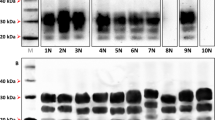Abstract
THE nature of the scrapie agent remains obscure. It shows an unusual resistance to heat1 and ultraviolet radiation2, and cannot be inactivated by treatment with lipid solvents3 or formalin4. It resists treatment with proteases and nucleases5,6. Its size is quite small and has been estimated to be 27 mµ by cellulose nitrate membrane filtration7, and 7 mµ by X-ray target size determination2. No neutralizing antibody against scrapie has been detected in animals with the disease, nor could any antibodies be induced in rabbits injected with large quantities of scrapie-containing material7. Yet scrapie is considered an infectious agent, and it has been placed in the category of slow viruses because of its prolonged incubation period (1–2 yr in sheep; 4–6 months in mice).
This is a preview of subscription content, access via your institution
Access options
Subscribe to this journal
Receive 51 print issues and online access
$199.00 per year
only $3.90 per issue
Buy this article
- Purchase on Springer Link
- Instant access to full article PDF
Prices may be subject to local taxes which are calculated during checkout
Similar content being viewed by others
References
Stamp, J. T., Brotherston, J. G., Zlotnik, I., Mackay, J. M. K., and Smith, W., J. Comp. Pathol., 69, 268 (1959).
Alper, T., Haig, D. A., and Clarke, M. C., Biochem. Biophys. Res. Commun., 22, 278 (1966).
Eklund, C. M., Hadlow, W. J., and Kennedy, R. C., Proc. Soc. Exp. Biol. and Med., 112, 974 (1963).
Pattison, I. H., J. Comp. Path., 75, 154 (1965).
Haig, D. A., and Clarke, M. C., NINDB Monog. No. 2, 215 (1965).
Hunter, G. D., and Millson, G. C., J. Comp. Pathol., 301 (1967).
Gibbs, jun., C. J., Current Topics in Microbiol. and Immunol., 40, 44 (1967).
Vainio, T., Gwatkin, R., and Koprowski, H., Virology, 14, 385 (1961).
Hitchcock, G., and Porterfield, J. S., Virology, 13, 363 (1961).
Glasgow, L. A., Hanshaw, J. B., Merigan, T. C., and Petralli, J. K., Proc. Soc. Exp. Biol. and Med., 125, 843 (1967).
Author information
Authors and Affiliations
Rights and permissions
About this article
Cite this article
KATZ, M., KOPROWSKI, H. Failure to demonstrate a Relationship between Scrapie and Production of Interferon in Mice. Nature 219, 639–640 (1968). https://doi.org/10.1038/219639a0
Received:
Issue Date:
DOI: https://doi.org/10.1038/219639a0
This article is cited by
-
Developmental Maturation of Susceptibility to Scrapie in Mice
Nature (1973)
-
Slow infections of the central nervous system
Zeitschrift f�r Neurologie (1971)
-
Pathogenesis of Scrapie in the Mouse: the Role of the Spleen
Nature (1970)
Comments
By submitting a comment you agree to abide by our Terms and Community Guidelines. If you find something abusive or that does not comply with our terms or guidelines please flag it as inappropriate.



